Questions
-
- The table shows the results, which were obtained in an experiment on the behaviour of a gas.
Temperature oC 15 30 45 60 76 90 Volume (cm3) 42 45 47.5 51 54 57 - Plot a graph of volume against temperature,
- Using the graph, determine the constant of proportionally k of the relationship for this range of temperature.
- The pressure of helium gas of volume 10 cm3 decreases to one third of its original value at a constant temperature. Determine the final volume of the gas.
- The table shows the results, which were obtained in an experiment on the behaviour of a gas.
- On a certain day when the temperature is 370c, the pressure in an open gas jar is 640mm of mercury. The jar is then sealed and cooled to the temperature of 170c. Calculate the final pressure.
-
- State Boyle’s Law.
- The table shows the results of Boyle’s law experiment.
Pressure (atm) 1 1.3 1.5 1.8 2.3 2.6 3.2 2.7 Length of air column L (mm) 441 31 27.522 22 18 16 12.5 11 - Copy the table and add values of 1/L (mm-1)
- With the aid of a labelled diagram describe the apparatus and arrangements used in getting these results.
- Plot a graph of pressure against 1/L
- A student used the set up to investigate the variation of the volume of a trapped mass of air with pressure at constant temperature. By raising the open end of the tube he measured the corresponding values of the length L of the air column and the excess pressure, h.
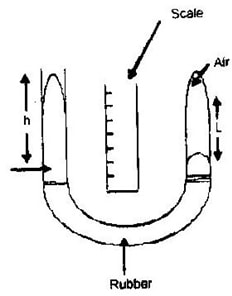
- In determining the volume V of the air he measured the length L of the air column.
- What is the relationship between L and V?
- State the assumption made?
- What is the significance of the excess pressure.
- The table shows the results obtained using the set up.
Volume of gas (cm3) 5.1 5.5 6.0 6.8 8.2 9.7 Excess pressure 291 224 123 77 -55 -139 - What does the negative excess pressure mean?
- Copy the table and add the values of I/V (cm3) and plot a graph of I/V against excess pressure.
- From the graph:
- Write an expression relating pressure and the volume of air.
- Determine the slope of the graph.
- Find the value of x of I/V when h = 0 and hence evaluate x/s. Comment on your answer.
- In determining the volume V of the air he measured the length L of the air column.
-
-
- Draw and label a diagram of the apparatus you would use to verify Charle’s law.
- Describe how to use the apparatus to verify the law.
- A gas has a volume of 20 cm3 at 270C and normal atmospheric pressure. Calculate the new volume of the gas if it is heated to 540C at the same pressure.
- Show that the density of a fixed mass of gas is directly proportional to the pressure at constant temperature.
-
- The figure shows changes in pressure, P, and volume V for a fixed mass of a certain gas.
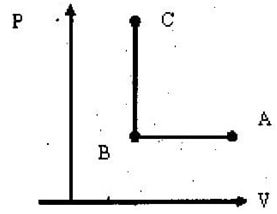
Write down a statement of the gas law, which holds true from A to B. -
- State the law that relates the volume of a gas to the temperature of the gas.
- The figure below shows an experimental set up that may be used to investigate one of the laws. The glass tube has a uniform bore and it is graduated in millimeters.
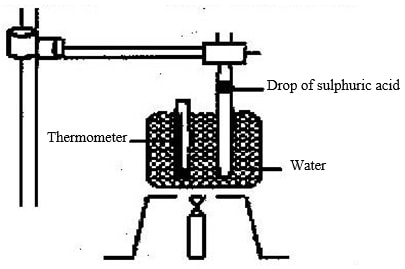
- Describe how the experiment is carried out and explain how the results obtained verify the law.
- State two limitations of the set up.
- Draw axes and sketch the P – V graph for a gas obeying Boyle’s Law.
- Two identical containers A and B are placed on a bench. Container A is filled with oxygen gas and B with hydrogen gas masses. If the containers are maintained at the same temperature, state with reason, the container in which pressure is higher.
-
- The figure below shows a simple set up for pressure law apparatus.
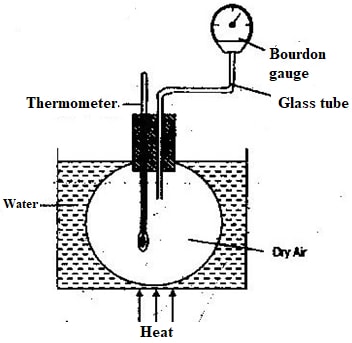
Describe how the apparatus may be used to verify pressure law. - The graph in the figure below shows the relationship between the pressure and temperature for a fixed mass of an ideal gas at constant volume.
- Given that the relationship between pressure, P, and temperature, t in Kelvin is of the form P = kT + C, where k and C are constants, determine from the graph, values of k and C.
- Why would it be impossible for pressure of the gas to be reduced to zero in practice?
- A gas is put into a container of fixed volume at a pressure of 2.1 x 105 Nm-2 and temperature 270C. The gas is then heated to a temperature of 3270C. Determine the new pressure.
- The figure below shows a simple set up for pressure law apparatus.
- Draw axes and sketch a graph of pressure (P) against reciprocal of volume (1/V) for a fixed mass of an ideal gas at a constant temperature.
- A balloon is filled with air to a volume of 200ml at a temperature of 293 K. Determine the volume when the temperature rises to 353 K at the same pressure (3mks)
- The graph in the figure below shows the relationship between the pressure and temperature for an ideal gas. Use the information in the figure to answer
questions that follow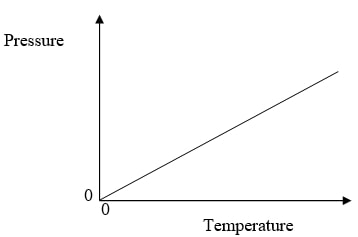
- State the unit of the horizontal axis. (1mk)
- Write a statement of the gas law represented by the relationship. (1mk)
- A balloon filled with organ gas a volume of 200 cm3 at the earth’s surface where the temperature is 200C, and the pressure 760mm of mercury. If it is allowed to ascend to a height where the temperature is 00C and the pressure 100mm of mercury, calculate the volume of the balloon.
- A mass of Oxygen occupies a volume of 0.01m3 at a pressure of 1 x 105 pa and a temperature 00C. If the pressure is increased to 5 x 106 pa and the temperature is increased to 250C. What volume will the gas occupy
- An empty barometer tube of length 90cm is lowered vertically with its mouth downwards into a tank of water. What will be the depth at the top of the tube when the water has risen 15cm inside the tube, given that the atmospheric pressure is 10m head of water?
- A hand pump suitable for inflating a football has a cylinder which is 0.24m in length and an internal cross-sectional area of 5.0 x 10-4 m2. To inflate the football the pump handle is pushed in and air is pumped through a one-way valve. The valve opens to let air in to the ball when the air pressure in the pump has reached 150 000 pa. (Assume the air temperature remains constant}
- If the pressure in the pump is initially 100 000 pa, calculate how far the piston must be pushed inwards before the one way valves opens.
- When the one-way valve opens the total pressure in the cylinder will be 150 000 pa. What force will be exerted on the piston by the air in the cylinder?
Answers
-
-
- Plot the graph (straight line)
- From PV = k, since P = const.
T
V= Const x T
Or y =mx
Where the constant = gradient of the graph
- P1V1 = P2V2
But P2 = 1/3P1
∴ V2 = P1 x V1 = P1 x 10 = 30cm3
P2 1/3P1
-
- P1 = P2
T1 T2
P2 = P1T2 = 740 x 290
T1 310
= 692.3 mm Hg -
- The pressure of a fixed mass of a gas is inversely proportional to the volume, provided temperature is constant.
-
- Obtain reciprocal values for L
-
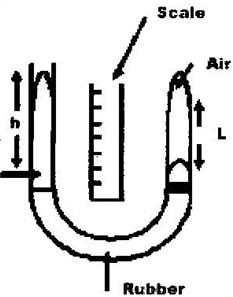
Raise or lower the open end and record corresponding values of pressure (dgh) against length of trapped air L (it represents volume) - Plot a graph of pressure against reciprocal values of length.
-
-
- Directly proportional since X- sec is uniform.
- Area of x - section is assumed to be constant
- Pressure above atmospheric pressure
-
- Pressure is below atmospheric value
- Plot the graph (straight line)
- Plot = K x 1/V
-
-
- A short pallet of mercury/concentrated sulphuric acid is introduced into the glass tube. As the temperature of air in the tube rises, it expands and pushes the mercury index further up the tube. The volume of air can be got from the length up to the level of the mercury index and temperature from the thermometer. The mercury thread is always at the same length so the total pressure in the tube remains constant. Plotting a graph of volume against temperature gives straight line which when extrapolated cuts the temperature axis at approximately 2730C.
- V1 = V2
T1 T2
V2 = 20 x 327
300
= 21.8cm3 - For a fixed mass of gas, pressure is inversely proportional to volume if temperature is kept constant
P α 1/Volume
P α 1 or density/mass
mass/density
∴ P α Density
- The pressure of a fixed mass of a gas is inversely proportional to the volume, provided temperature is constant.
-
- Charle’s Law – For a fixed mass of gas at constant pressure the volume is directly proportional to the absolute temperature.
-
- - Volume of gas is trapped by a drop of H2SO4. Water is heated and the gas is heated in a water bath.
- Volume/height of gas in tube is increased as the temperature rises
- Value of height, h, and temperature T are tabulated.
- A graph of volume V against temperature T is plotted
- A straight line graph cutting temperature axis at 2730C is obtained.
- Therefore volume is directly proportional to the absolute temperature. - Limitations
- Short temperature range
- Keeping pressure constant is difficult
- - Volume of gas is trapped by a drop of H2SO4. Water is heated and the gas is heated in a water bath.
-
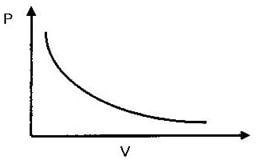
- B, Hydrogen is higher than oxygen hence moves faster, molecules collide more frequently with walls of container causing pressure to be more.
-
- - Heating of water/gas
- Recording values of temperature, pressure at intervals of different values
- Conversion of temperature to kelvin
- Plot a graph of temperature against absolute temperature or find the values of P/T = K
- Straight line graph obtained -
- C is the intercept and C=O
K is the gradient given by
15.2 x 104 – 4 x 104
400 – 105
11.2 x 104 = 380 + 10
295 - The gas would liquify
- C is the intercept and C=O
- C= 270C= 300K
3270C = 600K
P1 = P2 = 2.1 x 105 = P2
T1 T2 300 600
P2 = 4.2 x 105 p.a
- - Heating of water/gas
-

- V1 = V2
T1 T2
V2 =T2 x V1
T1
= 353 x 200 ml
293
= 241 ml -
- Kelvin (K)
- The pressure of a fixed mass of gas is directly proportional to its absolute (Kelvin) temperature provided the volume is kept constant. P α T at constant volume
- 1416 cm3
- 0.0022m3
- 1.25m
-
- 0.08m
- 75N
Join our whatsapp group for latest updates
Tap Here to Download for 50/-
Get on WhatsApp for 50/-
Download Gas Laws Questions and Answers - Physics Form 3 Topical Revision.
Tap Here to Download for 50/-
Get on WhatsApp for 50/-
Why download?
- ✔ To read offline at any time.
- ✔ To Print at your convenience
- ✔ Share Easily with Friends / Students

